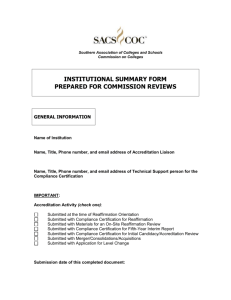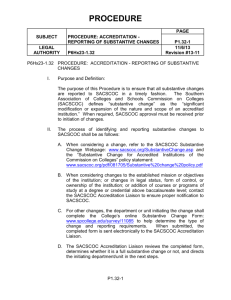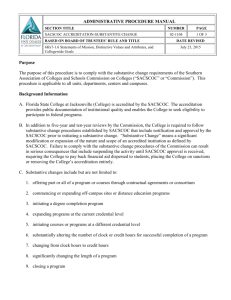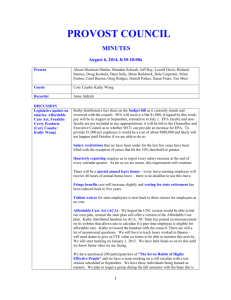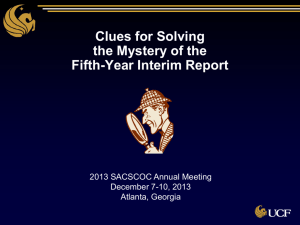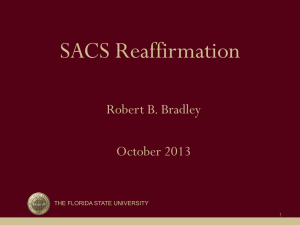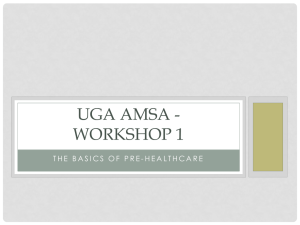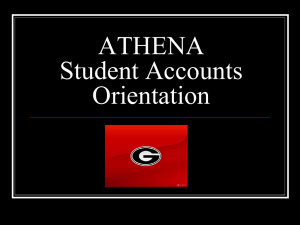Division of Student Affairs roles and responsibilities
advertisement
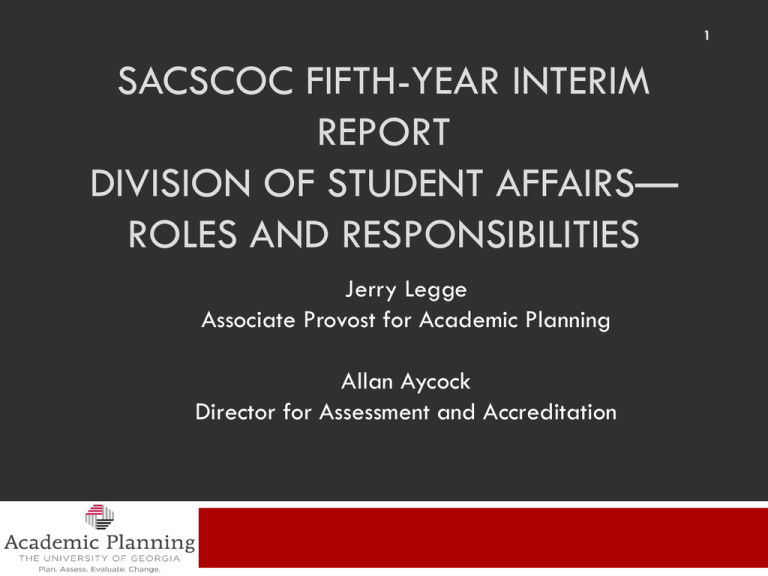
1 SACSCOC FIFTH-YEAR INTERIM REPORT DIVISION OF STUDENT AFFAIRS— ROLES AND RESPONSIBILITIES Jerry Legge Associate Provost for Academic Planning Allan Aycock Director for Assessment and Accreditation Today’s discussion 2 Overview of accreditation UGA approach to Fifth-Year Interim Report for SACSCOC Specific implications for UGA Student Affairs Division US Higher Education System 3 HEA—Federal Reauthorization ~5 years; next up in 2013 + FEDERAL REGS CHEA—”Recognizes” Accreditors SACSCOC—Regional Accreditor UGA—Accredited Why does accreditation matter? 4 $$$ Federal aid for students Federal grant funding for researchers Also, general recognition of level of quality How does UGA maintain accreditation? 5 Annual reporting and constant vigilance Decennial reaffirmation (2020-2021) Compliance Certification— Documents compliance with 100 + “Principles” of accreditation Quality Enhancement Plan Major project emerging from institutional assessment to improve student learning or the environment supporting student learning Fifth-Year Interim Report SACSCOC—Fifth Year Interim Report 6 History—new requirement Elements Abbreviated Compliance Certification—about 20 principles QEP Impact Report—First Year Odyssey Seminars SACSCOC—Fifth-Year Interim Report 7 Opportunities and Challenges for UGA Timeline Reports cover 2011-2016 Reports due in early 2017 Responsive to changes in federal regulations FYIR—Student Affairs Division 8 The Compliance Certification Principles involving the OVPSA are: Principle 2.10 (Student Support Services) Principle 3.3.1.3 (Institutional Effectiveness—Academic and Student Support Services) Principle 4.5 (Student Complaints) Resources 9 UGA SACSCOC Reaffirmation of Accreditation 2010-2011 Compliance Certification: https://sacs.uga.edu/compliance/index.html SACSCOC website Fifth-Year Interim Report section: http://www.sacscoc.org/FifthYear.asp SACSCOC Resource Manual: http://www.sacscoc.org/handbooks.asp SACSCOC Principle—FYIR 10 Principle 2.10. Student Support Services. The institution provides student support programs, services, and activities consistent with its mission that are intended to promote student learning and enhance the development of its students. And closely related: 3.3.1.3 Institutional effectiveness. The institution identifies expected outcomes, assesses the extent to which it achieves these outcomes, and provides evidence of improvement based on analysis of the results in . . . Academic and Student Support Service. FYIR 2.10 Checklist 11 UGA has Student Support Programs and Services that serve all levels of students (undergraduate—graduate) are accessible to extended campus and distance education students promote the mission of the institution for all students have clearly defined outcomes that demonstrate their intention to promote student learning and enhance the development of students And assessment processes are in place to determine student needs and interests measures attainment of outcomes and use the information to improve Ongoing 3.3.1.3 Checklist 12 student outcomes are defined for programs and services outcomes are focused on learning and development outcomes are related to UGA mission and goals assessment processes are in place, along with periodic review mature data and evidence that it is used for improving programs and services are available extended campuses and distance education students are included FYIR 2.10 Good news . . . 13 SACSCOC FYIR Statistics for Principle 2.10 Referrals for 2016 Track B Institutions (those with graduate programs) Only three of 34 Track B Institutions (9%) failed to demonstrate compliance with Principle 2.10 in their initial FYIR review. 3.3.1.3 Bad news 14 SACSCOC Decennial Review Statistics for 3.3.1.3 Annual Meeting in December 2012 indicates that of all institutions undergoing reaffirmation of accreditation during the prior year, 54.8% received citations for 3.3.1.3 during their off-site review, and 23.1% during the on-site review Made the top 5 !!! SACSCOC Principle 15 4.5 Student Complaints The institution has adequate procedures for addressing written student complaints and is responsible for demonstrating that it follows those procedures when resolving student complaints. Increased focus from federal regulation Especially with regard to distance education students Related SACSCOC Policy FYIR 4.5 Checklist 16 Written student complaints are addressed in a fair and professional manner The policies and procedures are well publicized and provide clear and consistent guidelines for complaint resolution Policies and procedures are followed Individuals/offices with responsibility are clearly identified Records of complaints with consistent elements are maintained Evidence/examples of resolved complaints are available FYIR 4.5 Fairly good news … 17 SACSCOC FYIR Statistics for Principle 4.5 Referrals for 2016 Track B Institutions (those with graduate programs) Only four of 34 Track B Institutions (12%) failed to demonstrate compliance with Principle 4.5 in their initial FYIR review. However . . . 8 of those institutions (24%) failed to demonstrate that their record of student complaints was in compliance. 18 Questions? Thank you. Office of Academic Planning http://www.oap.uga.edu/
